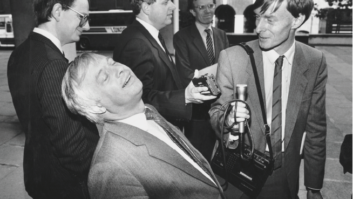The duty of the radio reporter today, whether for a commercial or non-commercial station, is the same as envisioned by Paul White when he stood up news bureaus all across America for CBS News. To wit: The reporter gathers news, whether by observation or interviewing; processes the news for broadcast; and submits completed reports to the newsroom.
But what tools are today’s reporters using? We talked with reporters and managers at four news operations.

Here’s what’s in Ryan Burrow’s “go bag.” He’s with WGN Radio in Chicago.
Photo by Ryan Burrow
HOW DO REPORTERS GATHER SOUND?
Separate audio recorders and microphone remain popular at many facilities.
Pat Duggins, news director for Alabama Public Radio and its stations in Tuscaloosa, Ala., still goes into the field with his Marantz PMD660 flash recorder and Audio-Technica ST95 Mark II microphone. “Some of the younger reporters like the all-in-one Zoom units. As long as it works, and if it’s transparent to the audience, it’s OK to me.”
Models of recorders we encountered for this story include the Zoom H2, Zoom H4 and Marantz PMD661. Microphones range from the venerable Electro Voice 635A to the Shure SM58 and the A-T model mentioned above.
Bruce Ferrell, assistant news director at Curtis Media Group — which owns WPTF Radio and the North Carolina News Network in Raleigh, N.C. — is among those who noted that gathering sound from streaming audio, whether in the newsroom or in the field, is part of the arsenal now.

Ryan Burrow, reporter for WGN Radio in Chicago, uses his Zoom H2 for pulling audio from streaming sources, if necessary, by running a cord from the laptop’s headphone jack into the H2’s input.
Don’t overlook video as a source for audio. Duggins covered a Civil War reenactment and used audio from the video he shot, mailing it back to himself in the newsroom.
TRANSMITTING STORIES
Emailed reports are becoming the norm. Live hits are certainly possible with smartphone apps like Tieline Report-IT (which KOMO uses to transmit studio grade sound over a cell network) and tools like Luci Live Lite, to name two examples.

There is a caveat, though. According to Pete Combs at KOMO Radio in Seattle, Apple’s decision to omit a headphone jack in recent iPhones made a lot of equipment obsolete.
“The iRig accessories needed to connect a microphone and/or laptop [for playback of recorded audio] no longer function. That leaves us with the ability to use Report-IT for live voice only using the phone’s on-board microphone.” So Combs uses a JK Audio Bluetooth device to get both live voice and recorded audio into the phone and back to the station for live shots on the cell phone when necessary.
At WPTF in Raleigh Burrow has a Comrex Access to go live from the field if necessary, but the primary method of getting news back to the newsroom is now email or FTP. The “alligator clip” for the 21st century radio reporter is now often a Wi-Fi hotspot.

Gear used by Pete Combs at Seattle’s KOMO News Radio.
Photo by Pete Combs
EDITING
Adobe Audition is still a go-to program for reporters editing audio in the field or back in the studio. Burrow also uses smartphone app Voddio, which allows for multitrack editing on a smartphone, though he still prefers Adobe Audition, which is installed on his laptop. “I find that easier, especially when editing other elements” to a report.
Combs has been using Audition and its predecessor Cool Edit for the better part of 20 years; Audition is used, too, by WPTF and the North Carolina News Network.
For managing stories, Burrow, Ferrell, Combs and Duggins all mentioned NewsBoss news management software. For emailed submissions, the software has an ingest feature that lets the reporter in the field file to a certain email address and then the story goes into the system.
At WPTF, Ferrell says, “Editors here only have to make minor adjustments to get the story to the desk for our anchors. The sound goes straight into our virtual ‘cart rack.’”
LESSONS LEARNED
We asked these professionals for “lessons learned.”
From Burrow: Have multiple recording devices to limit mistakes and avoid missing content. This also helps in the era of social media. “Freeing up the phone is key, as interest has been growing in live tweeting, streaming video and taking photos. If there’s a press conference, and you’re plugged into a mult box, you want the freedom to grab [sound of] nearby protestors, or take photos, tweet or perhaps grab a nearby newsmaker without having to disassemble your feed.”
Combs: News vehicles like the Subaru Forrester used at KOMO can be equipped with many tools to help reporters file from the field, especially a scanner, two-way radio and beefed-up electrical system with a switchable power inverter. “Don’t forget to turn off the inverter when you’re done for the day. For occasions when I forget to do so, I have a portable battery jumper and keep it charged up regularly.”
Duggins covered news and the space program for NPR for many years while in Orlando, Fla. One device he found most useful for using with the mult box found at many news events was a turnaround cord, XLR male-to-XLR male, which effectively allowed the user to plug two microphones into one mult box output. Duggins also mentioned that a simple mic cord with a business card attached, plugged into a mult box, can save trouble if the reporter has to take the recorder and cover another aspect of an event.
What new or unusual audio tools and techniques are you using? We’d like to hear about them. Reach us at [email protected] with ideas.
Paul Kaminski, host and producer of msrpk.com’s Radio-Road-Test program, is a semi-retired radio reporter, most recently with CBS News, Radio. A longtime Radio World contributor, he is retired from the United States Army. Twitter: msrpk_com. Facebook: radioroadtest or PKaminski2468.










